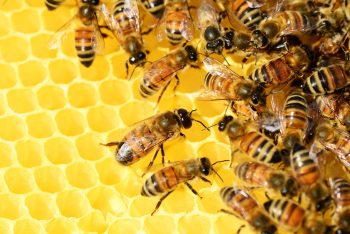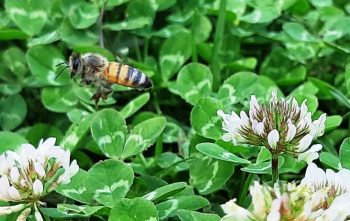Honey, Bees and Hives in Hebrew Posted by Ayana on Sep 17, 2018 in Uncategorized
Honey (דְּבַש) is an essential ingredient in the Jewish New Year dinner, as we’ve learned in the last post.
Various flavors of דְּבַש (pronounced de-vash) filled the supermarket shelves before the holiday; a small jar of דְּבַש is common among other treats given as gift; and during new year dinner, for a sweet new year we dip apple in דְּבַש.
Honey = דְּבַש
The honey = הַדְּבַש
This honey = הַדְּבַש הַזֶּה
דְּבַש is a masculine noun, and therefore its demonstrative pronoun, describing adjectives, and related verbs will be masculine as well. For example:
הַדְּבַש הַזֶּה טָעִים.
This honey is delicious.
כְּכָל שֶׁהַדְּבַש יוֺתֵר כֵּהֶה, כָּךְ הַטַּעַם יוֺתֵר חָזָק.
The darker the honey, the stronger the taste.
40 אָחוּז מְהַדְּבַש בְּיִשְׂרָאֵל נׅמְכַּר בְּרֹאשׁ הַשָּׁנָה.
40 percent of the honey in Israel is sold on Rosh Hashanah.
But when דְּבַש is part of a construct state, it isn’t neccessarily refered to as masculine. Because a construct state is two nouns combined together to create a third noun, the gender is determined by the first noun in the construct state. For example, the construct states עוּגַת דְּבַש (honey cake), צִנְצֶנֶת דְּבַש (honey jar), עוּגִיַּית דְּבַש (honey cookie), and חַלַּת דְּבַשׁ (honeycomb) are all feminine, because עוּגָה, צִנְצֶנֶת, עוּגִיָּיה וְחַלָּה are all feminine nouns.
דְּבַש is the product of a very industrious insect – the bee. דְּבוֹרָה (means “bee”, pronounced de-vo-ra) and is a feminine noun (as indicated by its ending with the letter ה). Its plural form, though, recieved the common masculine ending and ends with יׅם – דְּבוֹרִים. Both its single and plural form appear in the bible, and so is the use of this noun as a name. דְּבוֹרָה הַנְּבִיאָה (Deborah the prophet) was the only female judge mentioned in the Bible. דְּבוֹרָה is a common Hebrew name till our days. דְּבוֹרָה בַּאֲרוֺן and דְּבוֹרָה עוֺמֶר were great writers; דְּבוֹרָה קֵידָר is a 94 year old actress who still plays on the Israeli theater stage every week. Recently, though, the name דְּבוֹרָה lost its popularity in Israel, and fewer parents name their newborn daughter דְּבוֹרָה.
Bee = דְּבוֹרָה
The bee = הַדְּבוֹרָה
Bees = דְּבוֹרִים
The bees = הַדְּבוֹרִים
דְּבוֹרִים live in large groups in tumultuous hives. One hive (כַּוֶּרֶת) can contain up to 50,000 דְּבוֹרִים. The queen lays the eggs and rules the כַּוֶּרֶת. The workers produce the דְּבַש. The דְּבַש production begins outside the כַּוֶּרֶת. הַדְּבוֹרָה collects the nectar – a sugary liquid – from the flower with its long tongue and stored it in its extra stomach. She retunes to the כַּוֶּרֶת to deposit the דְּבַשׁ into the honeycomb. To produce a thick honey out of the viscous nectar, הַדְּבוֹרִים fan the honeycomb with their wings to evaporate the water, and then seal the comb, storing the honey for the cold winter.
Hive = כַּוֶּרֶת
Hives = כָּוָורוֺת
Nectar = צוּף
Flowers = פְּרָחׅים
This short video (with Hebrew subtitles) consists almost all of the vocabulary we’ve learned today:
For more practice watch this lovely girl joining her mother at her work as beekeeper:
Keep Calm and Learn Hebrew

Build vocabulary, practice pronunciation, and more with Transparent Language Online. Available anytime, anywhere, on any device.





